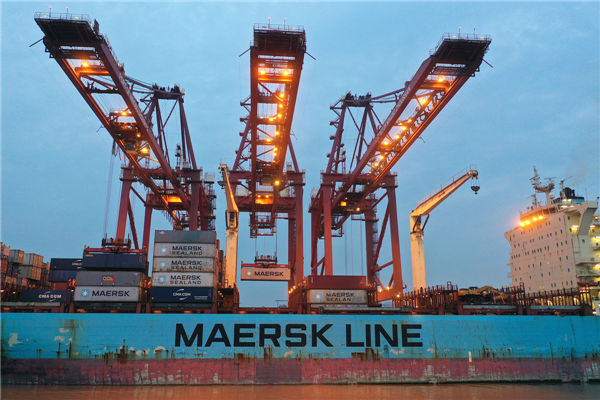Ningbo-Zhoushan Port embraces 'dual-circulation' pattern

A container vessel is berthed at the Jintang port area of Ningbo-Zhoushan Port in Zhejiang province in July. [Photo by Yao Feng/For China Daily]
Ningbo-Zhoushan Port in Zhejiang province is expected to play an increasingly prominent role in the building of China's new "dual-circulation" development pattern over the coming five years, said business leaders and experts.
Jiang Wei, board secretary of Ningbo Zhoushan Port Co Ltd, said integrated sea and rail transportation is the key to promoting imports and exports of cargo from China's inland regions, and the number of containers handled this way by the port is a clear indication that the new model of development, in which the domestic market is the mainstay and the domestic and international markets complement each other, is clearly taking shape.
Three of the 19 areas of Ningbo-Zhoushan Port-Zhenhai, Beilun and Chuanshan-now operate a total of 17 freight train routes connecting with 15 provincial regions, including the Tibet and Xinjiang Uygur autonomous regions, as well as European countries such as Germany and Hungary.
Major commodities handled by the port include auto parts, photovoltaic products, outdoor furniture, household appliances and electronic products.
"We have faith in China's economy as the country prepares for the 14th Five-Year Plan (2021-25), and we believe we will have solid foundations to progress further," Jiang said.
The port handled 3.05 million standard containers for domestic trade in the first three quarters, up 21 percent year-on-year. That number soared 38 percent year-on-year during the third quarter alone.
And the figure for October is expected to see a year-on-year increase of 29.5 percent, the company said on Nov 3.
Integrated sea and rail transportation is playing an increasingly important role in Ningbo-Zhoushan Port's operations, with the total annual volume of trade carried this way expected to exceed 1 million standard containers by the end of 2020, having already grown by 23 percent year-on-year in the first three quarters.
One of the latest examples of this integrated transportation strategy was seen with the departure of a freight train from Ningbo-Zhoushan Port on Oct 30 carrying 100 standard containers of cargo for the trading hub of Yiwu, Zhejiang province.
The considerable progress made by Ningbo-Zhoushan Port comes as China's economy recovers from the COVID-19 pandemic with the help of government measures to support hard-hit companies and prevent and control the pandemic.
China's GDP grew by 0.7 percent year-on-year in the first three quarters, turning positive after a contraction of 1.6 percent in the first half.
Ying Xiwen, a senior researcher at China Minsheng Bank Research Institute, said the third-quarter indicators proved that China's economy powered ahead of other major economies amid the global economic gloom incurred by the pandemic.

 Print
Print Mail
Mail
 20 Cultural Symbols
20 Cultural Symbols Why Zhejiang
Why Zhejiang Experiencing high-tech products at WIC
Experiencing high-tech products at WIC Zhejiang Release
Zhejiang Release Zhejiang News
Zhejiang News